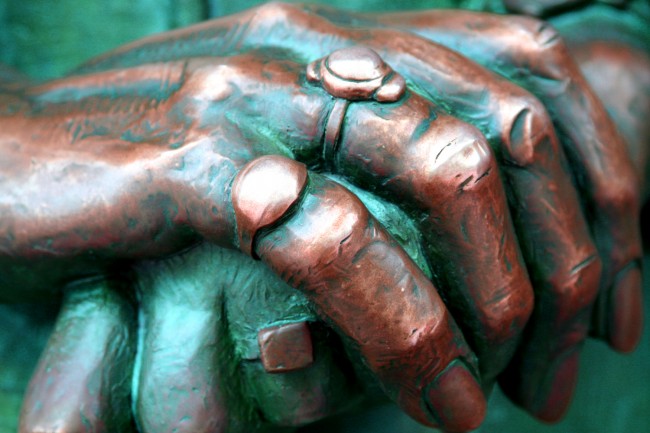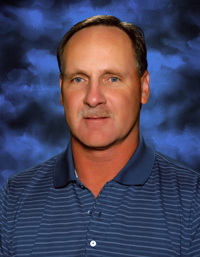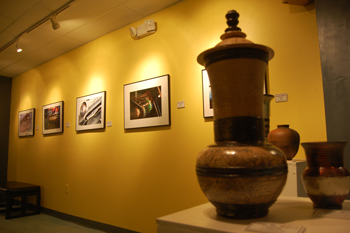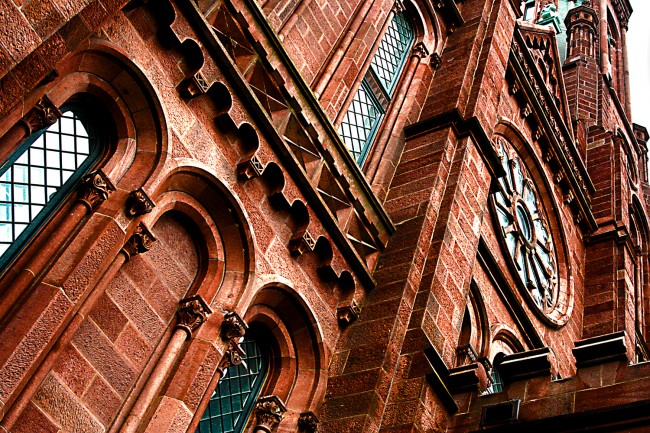
Tom Gargiulo created the Gargiulo Art Foundation 10 years ago with a few goals in mind: To foster and support Flagler County’s arts groups, to showcase local artists’ works in public and semi-public places, and to name an annual artist of the year.
The foundation has been doing all three. It buys and promotes the work of local artists with a kind of entrepreneurial generosity that helps the foundation carry on while subsidizing chronically struggling artists. Some 150 art works bought and donated through the foundation hang at the Daytona State College Palm Coast campus. Just last month the foundation donated a sculpture to Palm Coast—the stately panther, sculpted by Paul Baliker, that now sits at the eastern edge of Linear Park—that should be the first of many that will line the park and other public places, down to the public library on Belle Terre Parkway. The sculpture is the second such gift the city. The first was a sculpture by Innes Maisannes in 2007 that now sits in front of the Palm Coast Community Center on palm Coast Parkway.
Click On:
- The Panther Has Arrived
- How A Panther Broadened City Beauty Board’s Mission to Include Riches & Perils of Public Art
- Cultural Development Richer Than Economic: How to Grow Palm Coast Into a City With Soul
- Color and Provocation Surf Through Hollingsworth Gallery’s Latest Show
- Harmonic Shock Meets Art at Hollingsworth Gallery’s “Music Is the Muse”
But the foundation’s signature event is its artist of the year award. Started in 2000, when Peter Cerreta was the winner, the event has had something of a nomadic life, shuttling from the art gallery Gargiulo and Arlene Volpe kept going for several years in Bunnell to the Palm Coast campus of Daytona State College to, finally, what the foundation hopes will be its permanent home: JJ Graham’s Hollingsworth Gallery at City Market Place (formerly City Walk). Graham was last year’s artist of the year, so chosen, Gargiulo says, because of the verve and vision he brought to his gallery, which turned into the city’s most energetic arts hub soon after it opened two years ago.
“We’re not only looking for real good art,” Gargiulo says of the foundation’s process as it picks its artist of the year. “We’re also looking for artists who are supportive of the community, of art programs in the community, we’re looking for a resident that’s going to be here for a while.”

“All of his students that come here, they really love and appreciate this man,” Graham said of Beckett, “and so when Tom decided to give him the show he came to me and we talked about it, I thought it was a great idea. It was also great because he’s so well loved in the community, it brought out a lot of people who hadn’t necessarily been here to the gallery. That’s something that to me makes me slightly indebted to him. Having his show here helped the place. We had almost 200 people show up at the gallery, and most of them were here because they knew him.” Among them: Palm Coast Vice Mayor Holsey Moorman, who read a proclamation by the city honoring the foundation and Beckett’s “inspiring methods of design and creative photography.”
The show includes another Gargiulo standard: the affordable art display. Works are priced at $50 or less. This year Gargiulo, an artist who himself likes to work fast, encouraged artists to make works in 15 minutes or less. A few did. Many couldn’t keep to the constraint, so the suggestion was relaxed. Those works line half the walls of the gallery, the other half belonging to Beckett’s works.

He adds, “I could decorate those a lot of different ways but they’d never look like that without the raku process.”
Beckett, 51, has been an artist from as far back as he can remember, down to the means he used to try his first experiments. His first potter’s wheel was none other than one of those old record-playing turntables that an entire generation of CD-addled Americans would think of as something out of a sci-fi movie. He put a plastic sheet over the turntable and used it as his wheel. Things evolved from there. These days his main interest is photography. Black and white photography, to be precise, though he doesn’t limit himself to that. There’s a melancholy quality to his visual work, which is drawn to the details of the everyday: the shine of a taillight’s chrome, the ballsy (and not entirely unfallic) burden of a net, the grill of an old car, all of it weathered—sort of like the raku technique, but adapted to the digital age—by Beckett’s Photoshop manipulations, which he considers an extension of the artist’s craft: A digital brush is no different than an actual one.
Flagler Artists of the Year:
|
One of the things you notice most in Beckett’s photography is what’s not there: there are no people in his pictures, at least not in the works he chose to display at Hollingsworth. He’s more at home with the melancholy of junky Jeeps or old wagons, with the stolid colonnades of stately buildings or the communion of a decrepit country house with the emptiness aaround it, under electric lines that make a point of passing it by. Beckett’s comfort zone is the isolated, the off-center, the memorialized, even if by no one else but him. An old Jeep somehow has the same poignancy of one of the statues of a soldier from the Korean War memorial in Washington, D.C. (which shows a platoon of almost faceless soldiers marching, unquestioningly, toward nowhere in particular, the cold of their surrounding as cold as their sculpted stone). So when beckett does shoot people, they’re no longer there: like those soldiers or, literally, the “Memorial Collage” showing a shredded Bible and the yellowed portrait of a handsome man, the suggestion being that he died too soon.
A native of Wilmington, Ohio, and a father of three, Beckett has been an art teacher—photography, ceramics, graphic design—for 27 years, 22 of them at Palm Coast High School, which picked him as its teacher of the year in 2009. He’s one of the reasons the arts program at the high school is as rich as it’s been. This weekend is an example of his involvement beyond the classroom: he’s essentially curating the school’s visual arts show that’s part of the Flagler Auditorium’s Holiday Extravaganza, a five-day festival of local performing and visual arts designed to raise money for arts in education. The visual arts component is in the Black Box theater next to the auditorium all weekend.
Beckett’s goal these days is perhaps to move away from coaching (softball) and to focus more on his photography and return to the arts and craft shows he used to do around the state (at least eight a year), where he found much of his inspiration (“Those people have got to be the most creative people on earth,” Beckett says of the artists on the show circuit, “because if they don’t have that one thing nobody else does, they’re not going to sell their work”).
Tonight he’ll be back at Hollingsworth, along with Gargiulo, Volpe, Graham and many friends, part of that nascent community of artists he’s also helping to craft in a young city that not so long ago was a swamp in every sense of the term, and in some ways—with these artists providing the pontoons—is still struggling to learn not to be.

(Click on the image for larger view)




























Leave a Reply